African rainforests are some of the most biodiverse regions on the planet, housing a plethora of unique flora and fauna. Among these magnificent creatures, birds form an essential component of the ecosystem.
These avian species play various integral roles in the rainforest, maintaining ecological balance and providing crucial ecosystem services such as pollination, seed dispersal, and insect control.
The African rainforest is home to numerous bird species, ranging from colorful parrots, hornbills, and turacos to small passerines and swifts.
These birds exhibit fascinating behaviors, adapt to different niches, and interact with other animals in a complex web of relationships.
Therefore, exploring the birds of African rainforest is not only exciting but also essential to the conservation of the region’s biodiversity.
1. Chestnut Wattle-Eye
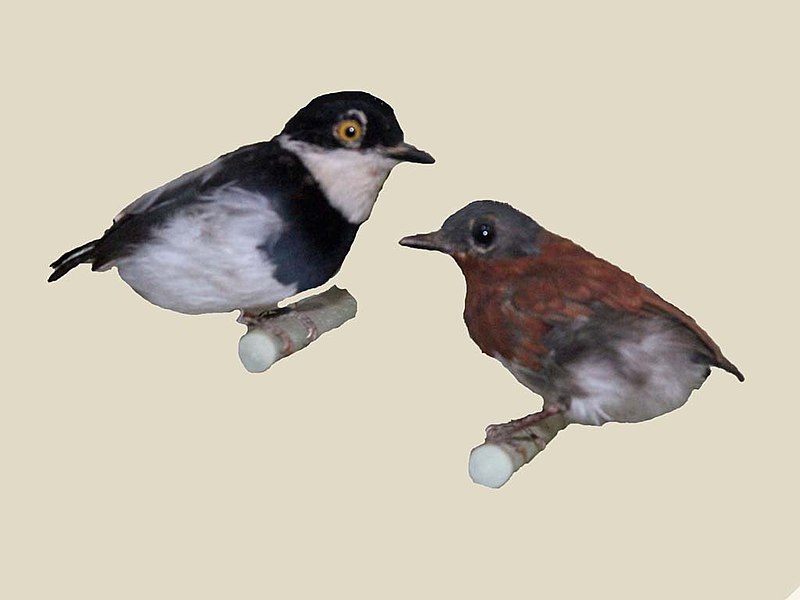
The Chestnut Wattle-eye is a species of bird found in Central and West Africa, from Angola to Zambia. It inhabits moist lowland forests as well as subtropical swamps and woodlands.
This small passerine has distinctive black eyes bordered by white, an olive green back with yellow edging on the wings, chestnut underparts and a bright red head patch.
Its diet consists mostly of insects like flies, moths and beetles which it catches in flight or gleans from foliage.
The Chestnut Wattle-eye also sometimes feeds on fruit while perched high up in trees – often seen alone but occasionally forming mixed flocks with other birds such as sunbirds or weavers.
With its vivid colours this unique little bird brings vibrancy to the African forest canopy.Scientific classification:
| Kingdom | Animalia |
| Phylum | Chordata |
| Class | Aves |
| Order | Passeriformes |
| Family | Platysteiridae |
| Genus | Platysteira |
| Species | P. castanea |
Also Featured In: Common Birds of Democratic Republic of the Congo,
2. Hornbill
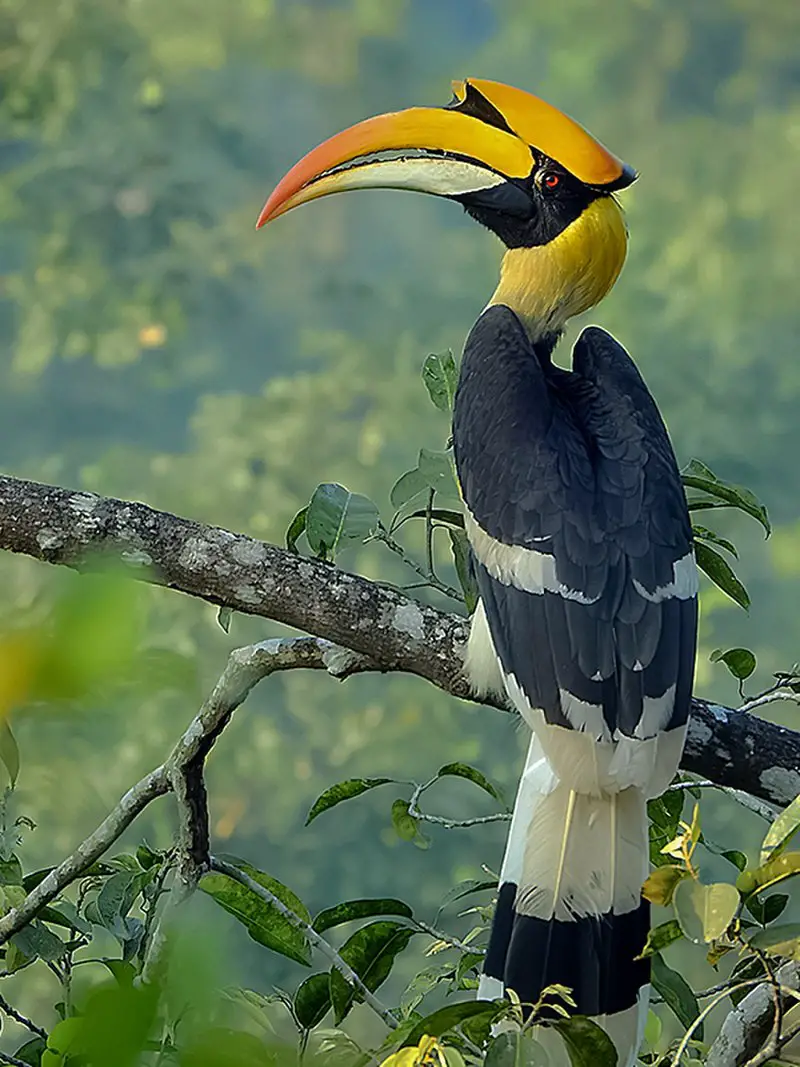
Hornbills are a tropical and subtropical bird species with characteristic long, curved bills. Their English and scientific names both refer to the shape of their bill which resembles that of a cow’s horn.
They have strong beaks for cracking open hard-shelled fruits as well as powerful wings for flying between trees or over great distances in search of food or mates.
Hornbills also feature beautiful plumage ranging from white to black feathers with yellow, brown, red and blue accents on the head, neck and back areas depending on the species.
In addition they often display brightly coloured casques – helmet like structures – atop their upper mandible adding further visual appeal to these majestic birds.Scientific classification:
| Kingdom | Animalia |
| Phylum | Chordata |
| Class | Aves |
| Order | Bucerotiformes |
| Family | Bucerotidae Rafinesque, 1815 |
Also Featured In: Birds of South African, Birds That Live in the Jungle
3. White-Necked Rockfowl
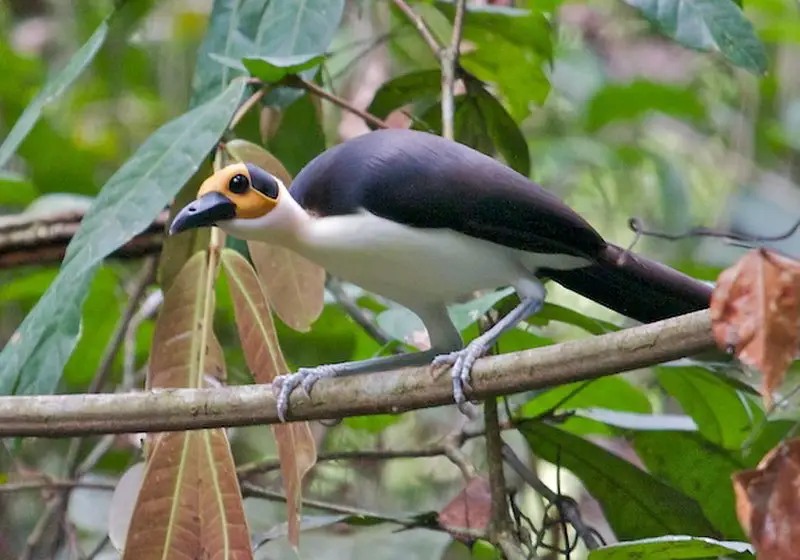
The white-necked rockfowl is a medium-sized bird found in West Africa from Guinea to Ghana. It has a distinctive long neck and tail, as well as predominantly grey feathers with contrasting black wings and beady eyes.
This passerine enjoys rocky forested areas at higher altitudes, but its distribution can be patchy due to isolation of populations from each other.
Its call is unique too; the rockfowl will often “choo” or make soft clucking noises when excited or frustrated.
These birds are quite shy and solitary by nature so it may take some patience to observe them in their natural environment.Scientific classification:
| Kingdom | Animalia |
| Phylum | Chordata |
| Class | Aves |
| Order | Passeriformes |
| Family | Picathartidae |
| Genus | Picathartes |
| Species | P. gymnocephalus |
Also Featured In: Common Birds In Ghana,
4. Picathartes
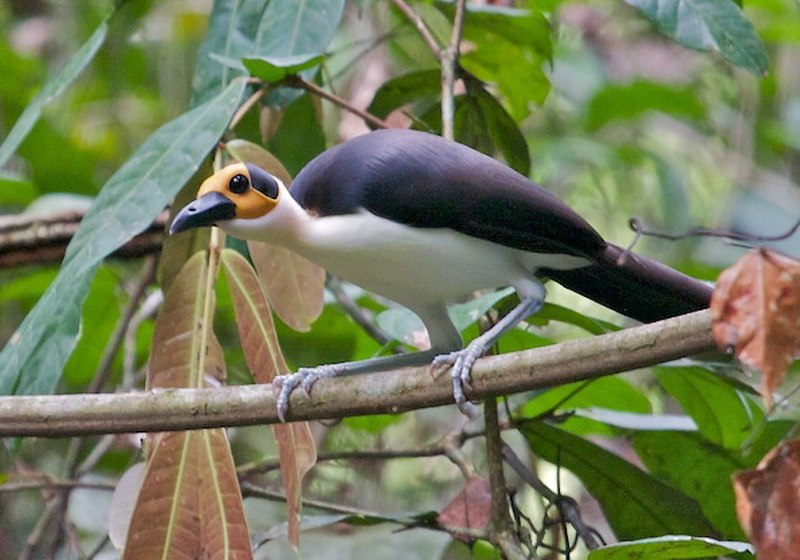
Picathartes birds are native to tropical West and Central Africa and belong to the Picathartidae family.
They have bare heads, which distinguish them from other passerines, and a strong preference for rocky jungles as their habitat.
Their diet consists primarily of insects and invertebrates picked up from damp rocks. Both species of picatharte bird are completely non-migratory due to their dependence on this specialized niche environment.
The two species in the genus include the white-necked rockfowl (or grey-headed picatharte) found in western Africa, eastern Nigeria through Cameroon.
As well as East African populations along Lake Victoria’s shoreline, Uganda’s forest edge riverside habitats etc.,and its close relative -the black or banded rockfowl found across central Africa including Gabon southward into Angola with an isolated population living around Mount Kilimanjaro in Tanzania too.Scientific classification:
| Kingdom | Animalia |
| Phylum | Chordata |
| Class | Aves |
| Order | Passeriformes |
| Family | Picathartidae Lowe, 1938 |
| Genus | Picathartes Lesson, 1828 |
5. Red-Billed Dwarf Hornbill
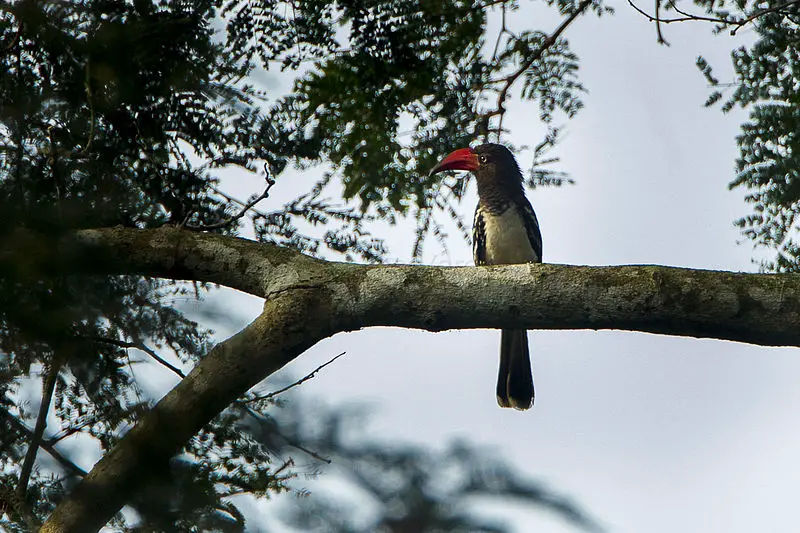
The red-billed dwarf hornbill is a species of bird found in the African tropical rainforest. It belongs to the Bucerotidae family and has a striking appearance, with its bright red bill contrasting against mainly black feathers.
Its wings are long and pointed, helping it to fly through dense vegetation quickly. The diet of this small hornbill consists mostly of insects, fruit and seeds.
They live both solitarily or in pairs but may form larger flocks during breeding season when they search for mates together.
These birds build their nests high up into tree hollows where they lay their eggs before taking turns incubating them until hatching occurs – an amazing example of teamwork.
Red-billed dwarf hornbills really are remarkable creatures that help keep natural ecosystems balanced throughout Africa’s lush forests; we should all do our part in protecting these majestic animals from extinction so future generations can appreciate them too.Scientific classification:
| Kingdom | Animalia |
| Phylum | Chordata |
| Class | Aves |
| Order | Bucerotiformes |
| Family | Bucerotidae |
| Genus | Lophoceros |
| Species | L. camurus |
Also Featured In: Common Tropical Rainforest Birds,
6. Yellow-Casqued Hornbill
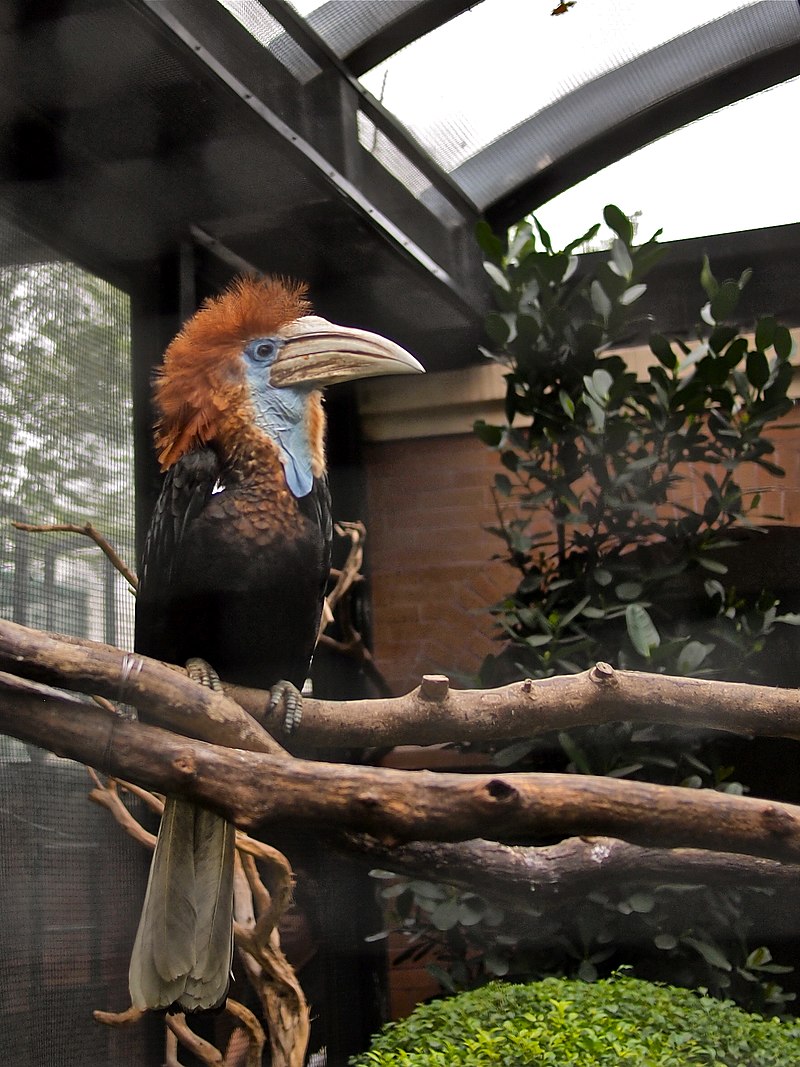
The Yellow-casqued Hornbill is an impressive bird found in the rainforests of West Africa. It has a bright yellow casque on its head and weight up to 2kg, making it one of the largest birds in its region.
Its primary habitat is in the canopy where they feed mostly on fruits, insects and small animals like lizards or frogs.
They are known for their loud calls which can be heard from far away during mating season when pairs join together to nest near tree hollows or cavities built by other species.
A monogamous pair stays together throughout breeding season with both parents taking turns incubating eggs and feeding chicks until they’re able to fly off into independence day.
These unique creatures have adapted well to their environment since ancient times, but due habitat destruction and human hunting activity threaten this species greatly today forcing conservationists across continents fight for their protection through policy change and public awareness campaigns.Scientific classification:
| Kingdom | Animalia |
| Phylum | Chordata |
| Class | Aves |
| Order | Bucerotiformes |
| Family | Bucerotidae |
| Genus | Ceratogymna |
| Species | C. elata |
Also Featured In: Birds of Côte d’Ivoire,
7. Afep Pigeon
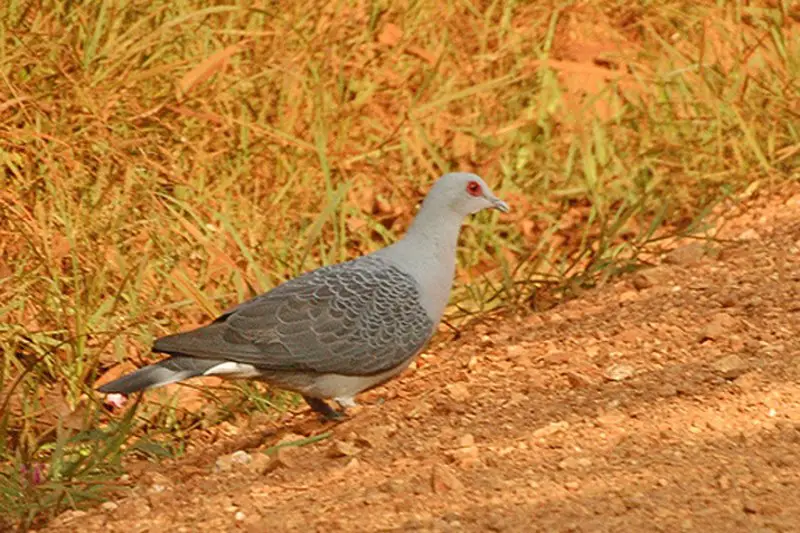
The Afep pigeon, also known as the African wood-pigeon or gray wood-pigeon, is a species of bird that can be found in the Equatorial Forests of Africa.
This bird was first described by the American ornithologist John Cassin in 1860, after he collected a specimen from the Ogooué River in Gabon.
The scientific name given to this pigeon is Columba unicincta. The Afep pigeon belongs to the family Columbidae and is known for its gray coloration.
They are known to live in the dense forest areas and feed on fruits and seeds found on the forest floor. These pigeons can grow up to a length of 41 cm and have a wingspan of 72 cm.
The Afep pigeon is a beautiful and important part of the ecosystem in the Equatorial Forests.Scientific classification:
| Kingdom | Animalia |
| Phylum | Chordata |
| Class | Aves |
| Order | Columbiformes |
| Family | Columbidae |
| Genus | Columba |
| Species | C. unicincta |
8. Lemon-Bellied Crombec
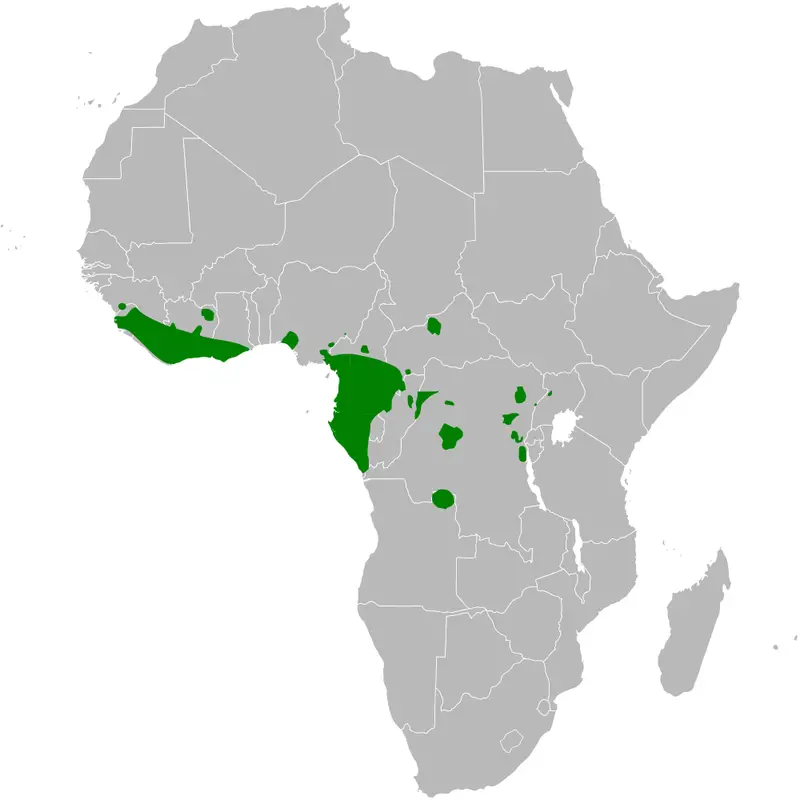
The Lemon-bellied Crombec is an African warbler that used to be classified under the Sylviidae family.
These birds can be found in areas with tropical or subtropical moist shrublands and lowland forests throughout the African continent.
They have a lemon-colored belly, hence their name, and are sparsely present in the tropical rainforests of Africa.
These birds are the most active during the breeding season, with both male and female birds sharing the responsibility of building the nest.
They are known for their unique and melodious songs that can be heard from a distance. Their diet primarily consists of insects and arthropods, which they catch by hovering and darting through the foliage.
The Lemon-bellied Crombec is a beautiful bird that adds to the colorful biodiversity of the African continent.Scientific classification:
| Kingdom | Animalia |
| Phylum | Chordata |
| Class | Aves |
| Order | Passeriformes |
| Family | Macrosphenidae |
| Genus | Sylvietta |
| Species | S. denti |
9. Sabine’s Puffback
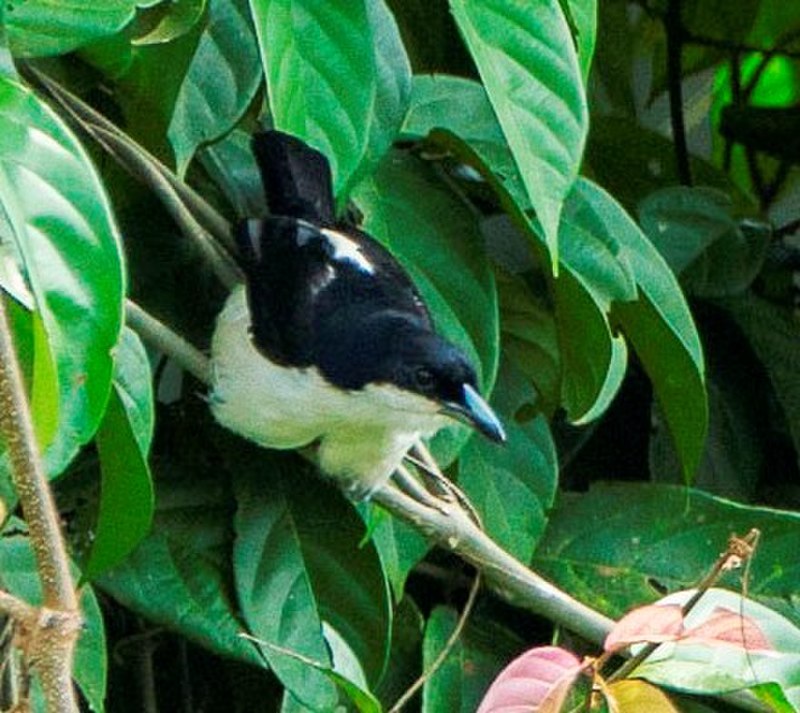
Sabine’s puffback is a type of bird belonging to Malaconotidae family. Indigenous to African tropical rainforests, these birds are found in Western and Central Africa.
These birds are mostly seen in moist lowland forests or swamps. They are also known as the large-billed puffback, and their scientific name is Dryoscopus sabini. The name of these birds is in commemoration of Sabine, the bird collector.
The Sabine’s puffback bird is a unique species that has distinct large bill and enjoys the tropical climate. They are fascinating creatures that attract bird enthusiasts worldwide.Scientific classification:
| Kingdom | Animalia |
| Phylum | Chordata |
| Class | Aves |
| Order | Passeriformes |
| Family | Malaconotidae |
| Genus | Dryoscopus |
| Species | D. sabini |
10. Dusky Crested Flycatcher
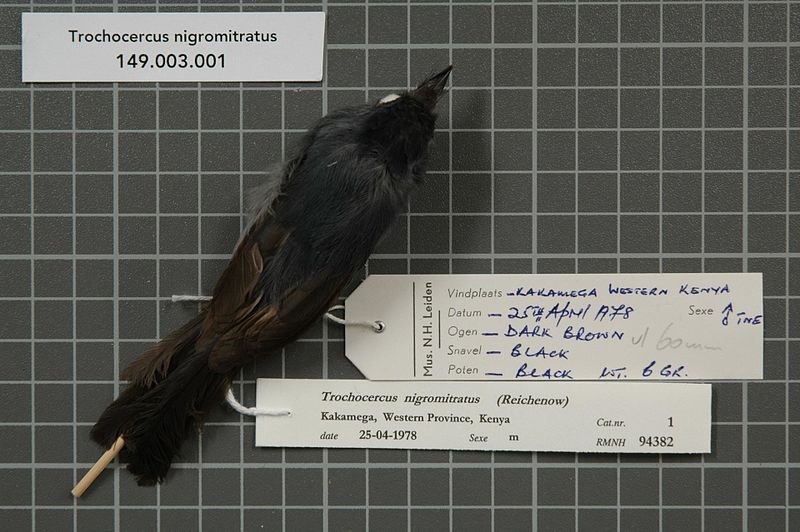
The Dusky crested flycatcher is a bird species found in African rainforests. They are members of the Stenostiridae family and are commonly found in subtropical or tropical moist lowland and montane forests.
The bird’s scientific name is Elminia nigromitrata. The bird’s body is characterized by a dusky grey color and a distinctive crest on top of the head, which gives it a distinct appearance.
The Dusky crested flycatcher bird is known to feed on insects while hunting from a perch, and they can also take insects while in flight.
They are common in many areas of Africa, and their status is not currently considered at risk.
Overall, Dusky crested flycatchers are fascinating birds to observe in their natural habitats.Scientific classification:
| Kingdom | Animalia |
| Phylum | Chordata |
| Class | Aves |
| Order | Passeriformes |
| Family | Stenostiridae |
| Genus | Elminia |
| Species | E. nigromitrata |
11. Fiery-Breasted Bushshrike
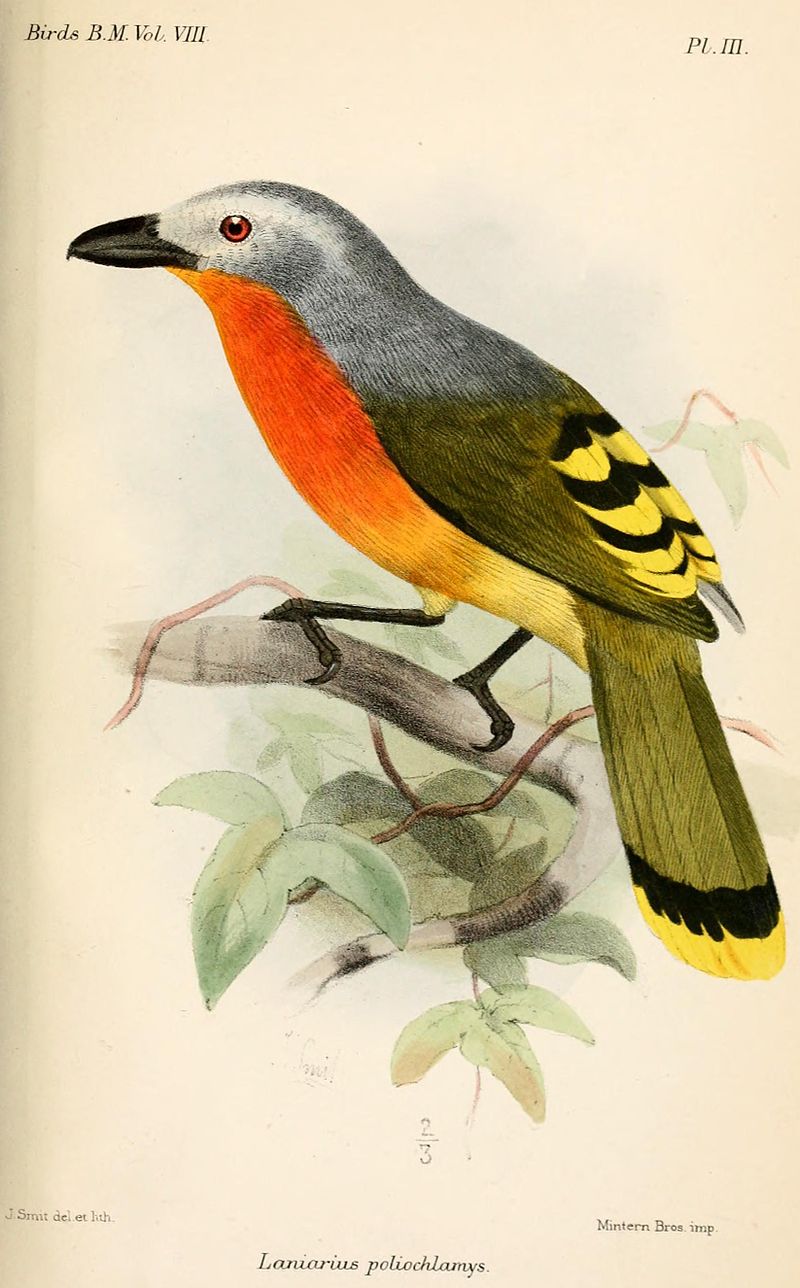
The fiery-breasted bushshrike, a member of the Malaconotidae family, can be found across the African tropical rainforest.
This bird species prefers to live in areas with subtropical or tropical dry forests as well as moist lowland forests.
With its unique fiery breast pattern, this bushshrike is known for its distinguishable appearance.
They are small but emit a melodic call that can be heard echoing through the forest. Seen as top predators in their habitats, these birds feed on insects and small animals.
Due to deforestation and habitat loss, the fiery-breasted bushshrike population has been declining.
Despite this, they remain one of the many special bird species that call the African tropical rainforest home.Scientific classification:
| Kingdom | Animalia |
| Phylum | Chordata |
| Class | Aves |
| Order | Passeriformes |
| Family | Malaconotidae |
| Genus | Malaconotus |
| Species | M. cruentus |
12. Olivaceous Flycatcher
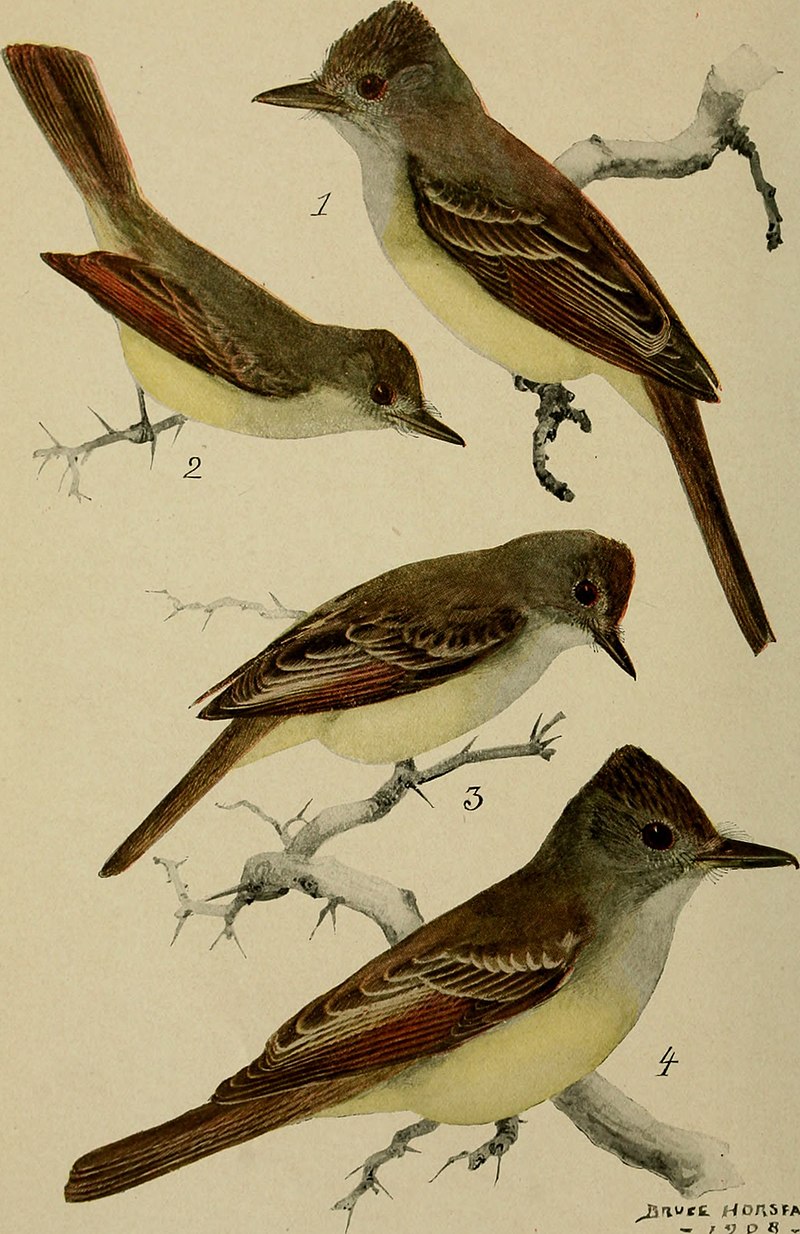
The Olivaceous flycatcher bird, also known as the olivaceous alseonax, belongs to the Muscicapidae family.
It is located in the African tropical rainforest and can be found in subtropical or tropical moist lowland forests and swamps.
This species has sparse distribution throughout its habitat. The bird is a small passerine bird with brownish-gray feathers, and it mainly feeds on insects, particularly flies.
Its unique characteristic is its ability to hunt its prey by perching on tree branches and rapidly flying out to catch insects mid-air.
These birds are not common to find, but when spotted, they are an exquisite sight to see.
Due to its scarce distribution, the Olivaceous flycatcher bird is not listed as an endangered species; however, habitat destruction and deforestation pose a potential threat to this species in the future.Scientific classification:
| Kingdom | Animalia |
| Phylum | Chordata |
| Class | Aves |
| Order | Passeriformes |
| Family | Muscicapidae |
| Genus | Muscicapa |
| Species | M. olivascens |
13. Yellow-Mantled Weaver
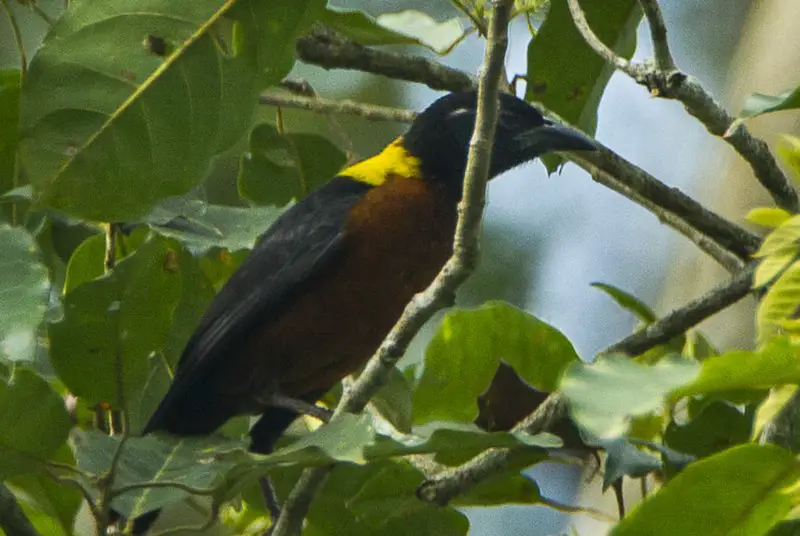
The Yellow-mantled weaver is a bird that belongs to the Ploceidae family. This species is known for its sparse distribution across the African tropical rainforest.
They have a unique yellow mantle, or patch of feathers, which distinguishes them from other weavers.
The Yellow-mantled weaver is a skilled builder of elaborate nests, which they weave with blades of grass or other plant material.
They usually build their nests in a tree or bush, hanging them from a branch. The male Yellow-mantled weaver is known for its bright, colorful plumage during the mating season, which it uses to attract a female mate.
This bird is considered a treasure of African biodiversity and can be spotted in the wild by keen birdwatchers.Scientific classification:
| Kingdom | Animalia |
| Phylum | Chordata |
| Class | Aves |
| Order | Passeriformes |
| Family | Ploceidae |
| Genus | Ploceus |
| Species | P. tricolor |
14. Cassin’s Hawk-Eagle
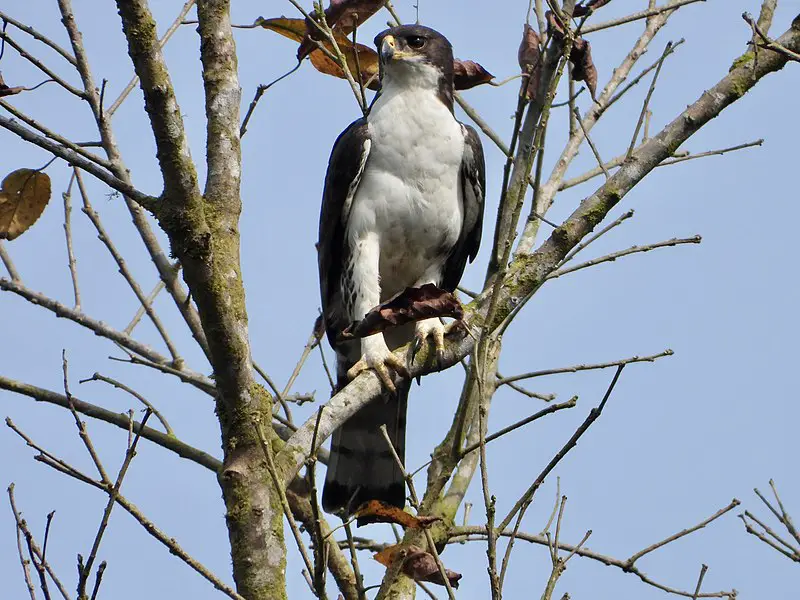
The Cassin’s hawk-eagle, also known as Cassin’s eagle, is a small eagle belonging to the Accipitridae family. It can be identified as a member of the Aquilinae subfamily by its feathered legs.
This forest-dependent species thrives in primary rainforests across western, central, and partially eastern Africa. Preying on birds and tree squirrels, the Cassin’s hawk-eagle feeds on its primary food sources.
The bird was named after John Cassin, who first described it. It is an impressive bird with notable features, including sharp talons and beak, along with excellent visual acuity.
With these traits, the Cassin’s hawk-eagle is a skilled hunter in its natural habitat.
Overall, this bird is a fascinating example of the beautiful diversity present in the world of avian species.Scientific classification:
| Kingdom | Animalia |
| Phylum | Chordata |
| Class | Aves |
| Order | Accipitriformes |
| Family | Accipitridae |
| Genus | Aquila |
| Species | A. africana |
15. Bates’s Sunbird
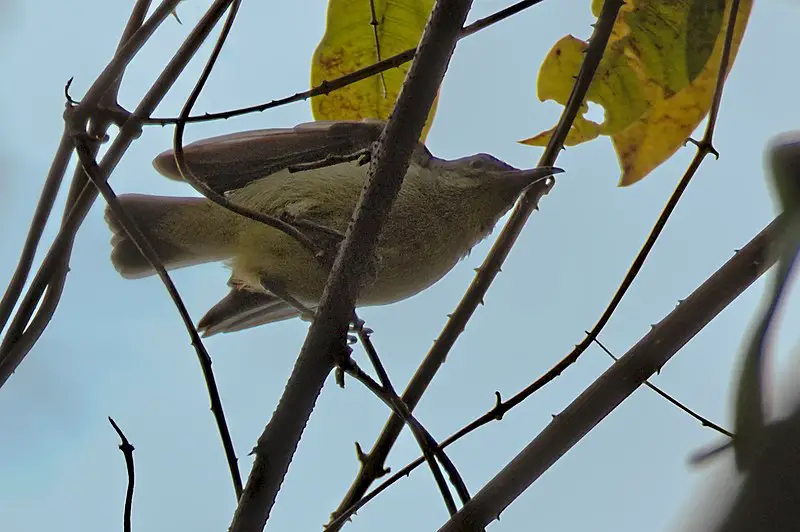
Bates’s sunbird, a tiny bird belonging to the Nectariniidae family, is found in forests in Western and Central Africa. This species is the only one of its kind.
It is easily identified by its short, curved bill, short tail, and yellowish belly. The male Bates’s sunbird has dark olive upperparts and a faint green color on its head, while the female is duller in color.
This bird’s natural habitat is in Central African rainforests and other forest types in Central Africa.
Overall, the Bates’s sunbird is an exquisite creature that adds to the beauty of the lush forest habitats in which it thrives.Scientific classification:
| Kingdom | Animalia |
| Phylum | Chordata |
| Class | Aves |
| Order | Passeriformes |
| Family | Nectariniidae |
| Genus | Cinnyris |
| Species | C. batesi |
16. Red-Tailed Bristlebill
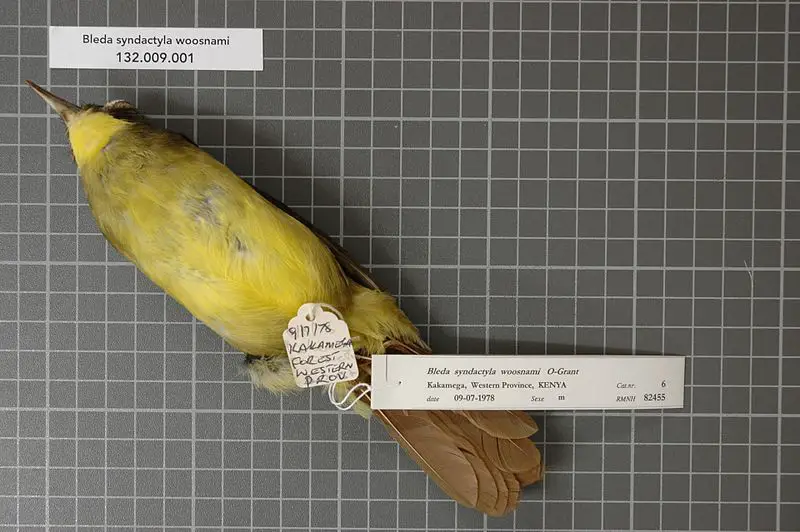
The red-tailed bristlebill is a commonly found bird in the African tropical rainforest. Belonging to the bulbul family, it is also known as the common bristlebill.
Originally described under the genus Dasycephala, this bird has two recognized subspecies. With its striking red tail, the bristlebill is a sight for sore eyes. Its scientific name is Bleda syndactylus.
As a member of the Pycnonotidae family, it is also considered a songbird. The red-tailed bristlebill is a unique bird, and its presence in the African region adds a touch of diversity to the ecosystem.Scientific classification:
| Kingdom | Animalia |
| Phylum | Chordata |
| Class | Aves |
| Order | Passeriformes |
| Family | Pycnonotidae |
| Genus | Bleda |
| Species | B. syndactylus |
17. Brown-Chested Alethe
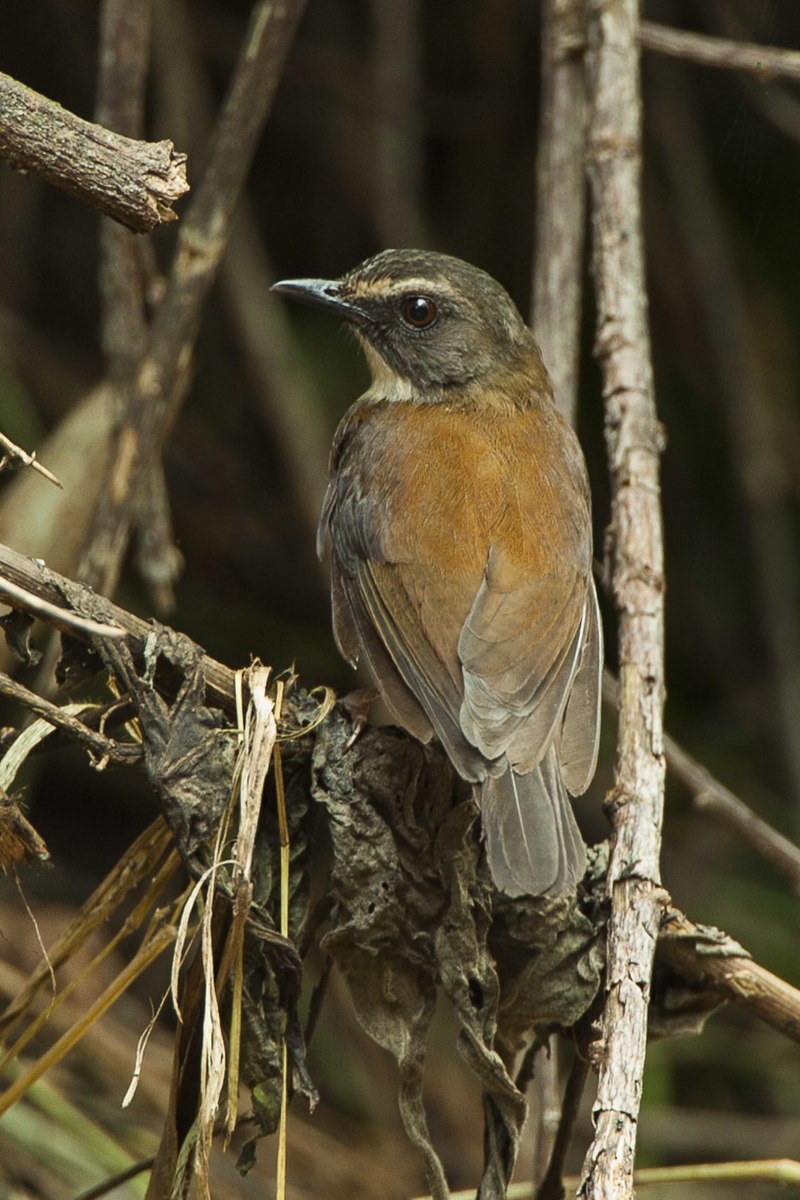
The Brown-chested alethe is a bird species found in African tropical rainforests. It has a partial range of presence and can be seen in subtropical or tropical moist lowland forests as well as subtropical or tropical moist montane forests.
This species belongs to the Muscicapidae family and is known for its distinct brown chest. They also have a poliocephala head or gray-colored head.
Due to these unique features, this bird is easy to identify. The Brown-chested alethe is a small-sized bird and primarily feeds on insects.
They are known for their melodious songs and are often heard singing during breeding seasons. This species’ natural habitat is under threat due to deforestation and habitat degradation, which has led to a decline in population.Scientific classification:
| Kingdom | Animalia |
| Phylum | Chordata |
| Class | Aves |
| Order | Passeriformes |
| Family | Muscicapidae |
| Genus | Chamaetylas |
| Species | C. poliocephala |
18. Little Grey Greenbul
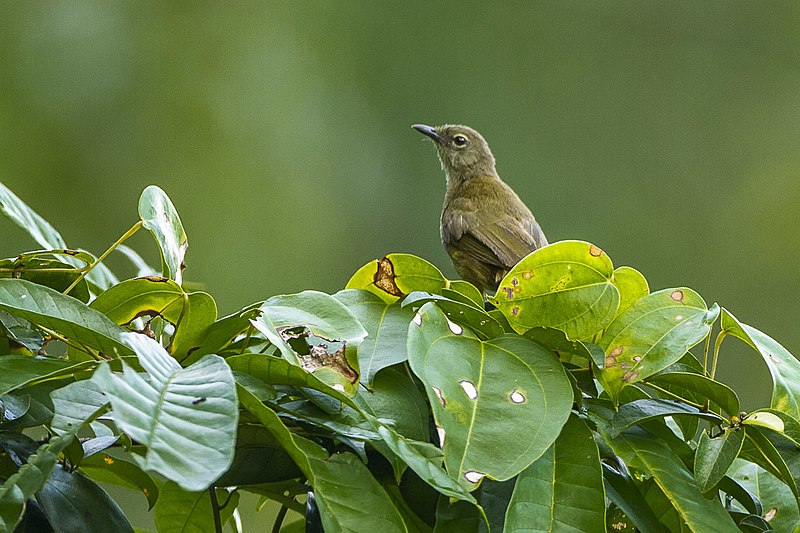
The little grey greenbul is a type of passerine bird found in African tropical rainforests. It favors habitats such as moist lowland forests and swamps.
Formerly classified in the genus Andropadus, it was re-classified to the genus Eurillas in 2010. The bird has a grey-green plumage, which gives it its name.
It is relatively small in size and belongs to the bulbul family. This species has a wide distribution across Africa.
Despite being common, the little grey greenbul may at times be difficult to spot due to its habitat preferences.
Overall, it is a fascinating bird with unique characteristics and an important role in the ecosystem of the African rainforests.Scientific classification:
| Kingdom | Animalia |
| Phylum | Chordata |
| Class | Aves |
| Order | Passeriformes |
| Family | Pycnonotidae |
| Genus | Eurillas |
| Species | E. gracilis |
19. Crowned Eagle
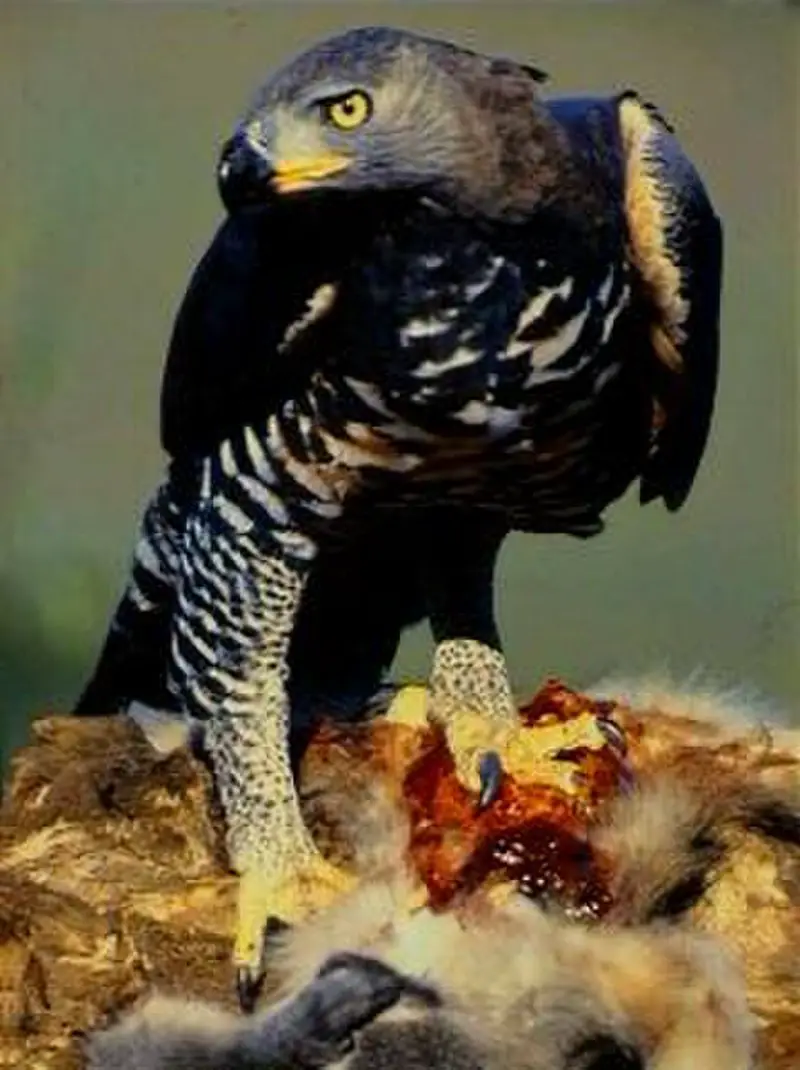
The Crowned eagle, also known as the African crowned eagle or the crowned hawk-eagle is commonly found in sub-Saharan Africa. This bird of prey prefers riparian woodlands and forests.
It is the only living member of the genus Stephanoaetus. Though in Southern Africa, it is limited to eastern areas.
The Crowned eagle is a large bird with impressive hunting skills. They are known to hunt medium-sized mammals like guinea fowl, rabbits, and hares.
The females are larger than the males and have a wingspan of over 6 feet. Their striking appearance and powerful talons make them an important symbol in African cultures.
However, the Crowned eagle is threatened by habitat destruction and hunting, which has resulted in a decrease in their population.
Conservation efforts are underway to protect this impressive bird of prey.Scientific classification:
| Kingdom | Animalia |
| Phylum | Chordata |
| Class | Aves |
| Order | Accipitriformes |
| Family | Accipitridae |
| Genus | Stephanoaetus |
| Species | S. coronatus |
Also Featured In: Common Carnivore Birds, Big Birds that Live in Uganda
20. Brown-Eared Woodpecker
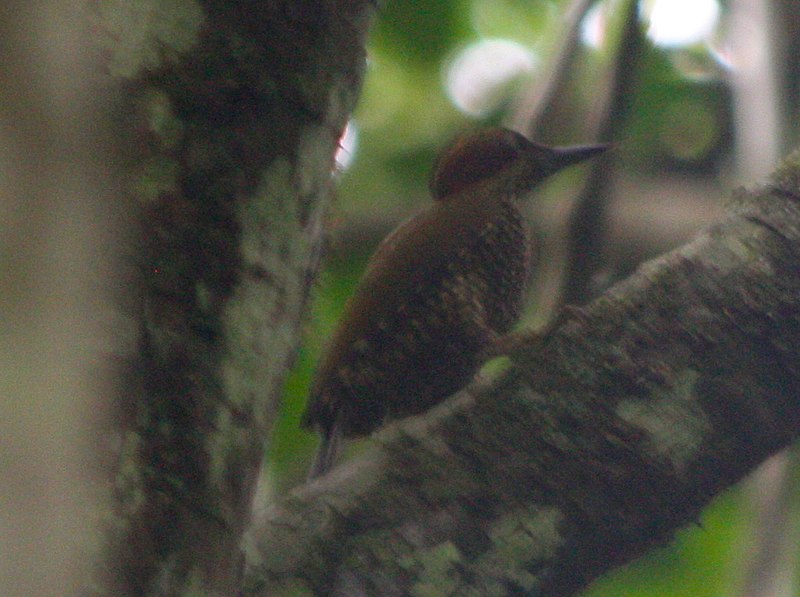
The Brown-eared woodpecker, a member of the Picidae family, is found in the African tropical rainforest. There are two subspecies of this bird, P. c. caroli and P. c. arizela, present in eastern and western parts of its range, respectively.
Despite being a common species in some areas, it has a wide range. The International Union for Conservation of Nature has not assessed its conservation status.
The bird is known for its distinctive brown ears, which are visible even from afar. It also has a sharp beak, which helps it dig into trees for food. The bird’s diet mainly consists of insects, which it finds by drilling holes into wood.
These woodpeckers are fascinating to watch due to their swift movements and unique feeding techniques.Scientific classification:
| Kingdom | Animalia |
| Phylum | Chordata |
| Class | Aves |
| Order | Piciformes |
| Family | Picidae |
| Genus | Pardipicus |
| Species | P. caroli |
21. Copper-Tailed Starling
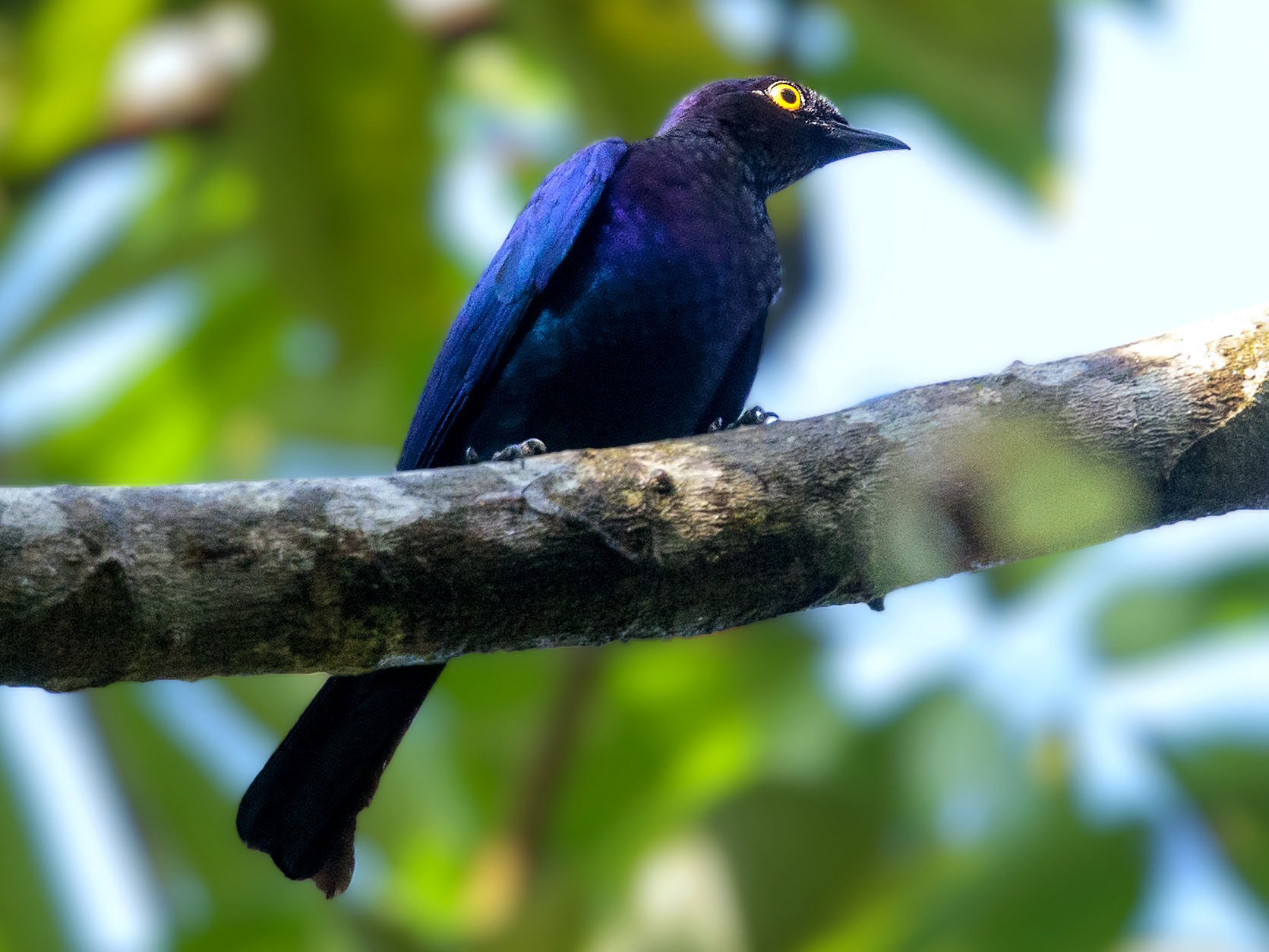
The Copper-tailed starling, also known as the Copper-tailed glossy-starling, is a species of bird belonging to the family Sturnidae.
It is found in various countries across West Africa including Ivory Coast, Ghana, Guinea, Liberia, and Sierra Leone.
These birds inhabit tropical moist lowland forests and are known to have a copper-hued tail.
Unfortunately, the Copper-tailed starling population is threatened due to habitat destruction. As their natural habitat continues to disappear, their numbers are declining.
Conservation efforts are needed to protect these beautiful birds and ensure their survival for future generations.Scientific classification:
| Kingdom | Animalia |
| Phylum | Chordata |
| Class | Aves |
| Order | Passeriformes |
| Family | Sturnidae |
| Genus | Hylopsar |
| Species | H. cupreocauda |
22. Grey-Throated Tit-Flycatcher
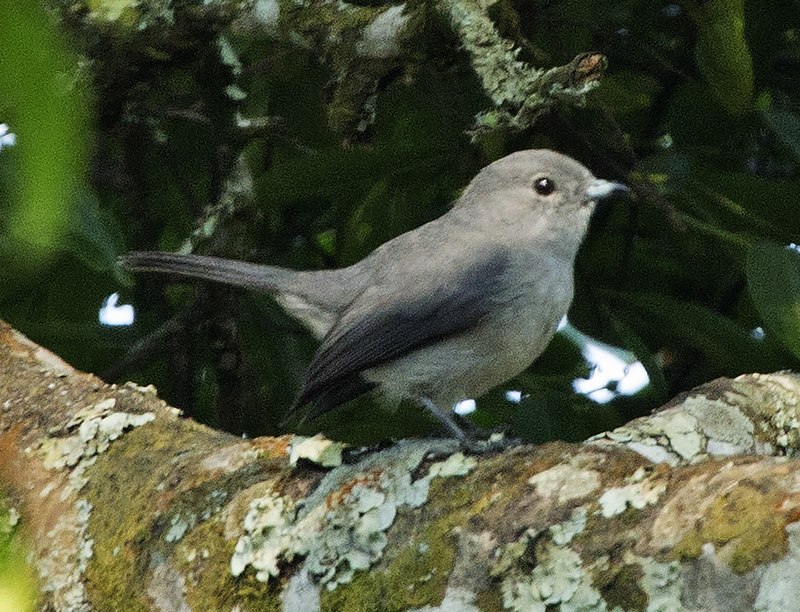
The Grey-throated tit-flycatcher is a beautiful bird belonging to the Muscicapidae family. This species is found in a number of African countries including Angola, Cameroon, Gabon, and Tanzania, among others.
As the name suggests, the bird has a grey throat and is known for its exceptional hunting skills. It can be spotted in subtropical or tropical moist lowland forests.
The Grey-throated tit-flycatcher is a sight to behold with its unique feather pattern and graceful movements.
It is a delight for birdwatchers and nature lovers alike, and its presence in the wild is truly a gift of nature.Scientific classification:
| Kingdom | Animalia |
| Phylum | Chordata |
| Class | Aves |
| Order | Passeriformes |
| Family | Muscicapidae |
| Genus | Myioparus |
| Species | M. griseigularis |
23. Red-Tailed Greenbul
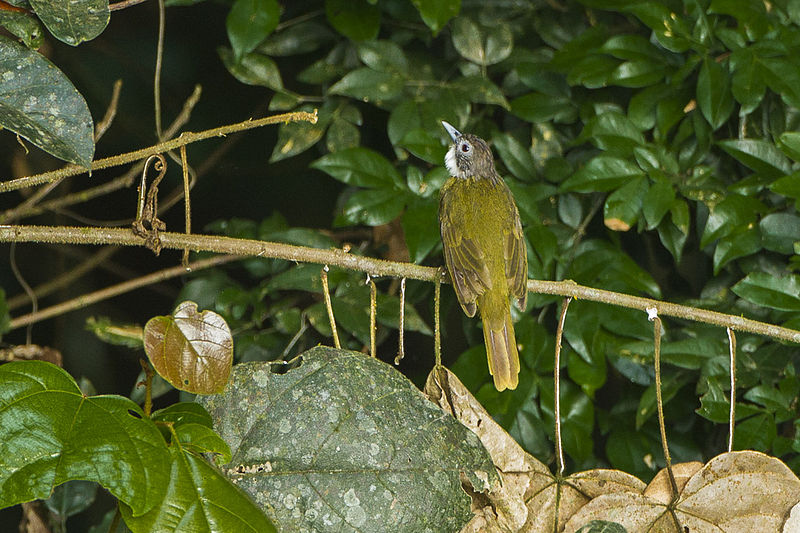
The Red-tailed Greenbul, scientifically known as Criniger calurus, is a species of songbird belonging to the bulbul family. This bird is commonly found in the African tropical rainforest.
It is also known as the Thick-billed Red-tailed Greenbul, Red-tailed Bearded Bulbul or simply Red-tailed Bulbul.
This bird has three recognized subspecies. The White-bearded Greenbul is sometimes considered conspecific with the Red-tailed Greenbul.
This bird has a distinctive red tail, which sets it apart from other greenbuls. It has a unique chirping and trilling song that is pleasant to the ear.
The Red-tailed Greenbul is a fascinating bird to observe in its natural habitat, and its unique characteristics make it an interesting addition to the avian world.Scientific classification:
| Kingdom | Animalia |
| Phylum | Chordata |
| Class | Aves |
| Order | Passeriformes |
| Family | Pycnonotidae |
| Genus | Criniger |
| Species | C. calurus |
24. Black-Capped Apalis
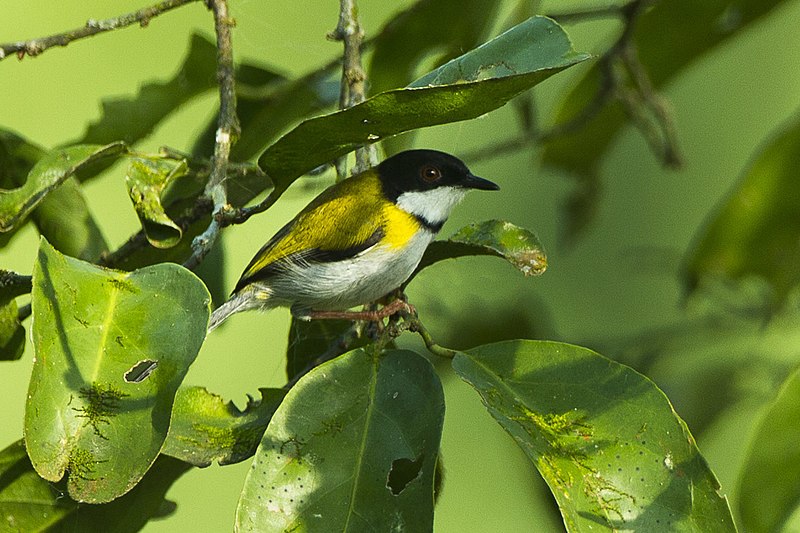
The black-capped apalis is a small bird found in the tropical rainforests of Sub-Saharan Africa. This species belongs to the family Cisticolidae and is known for its distinctive black cap.
Despite being sparsely distributed, this bird is quite active and can often be seen flitting among the trees in search of insects, which make up the bulk of its diet.
While its coloration may not be very remarkable, the black-capped apalis is known for its sweet, melodious song.
This bird is not considered to be in danger of extinction, but its rainforest habitat is increasingly threatened by human activities such as logging and agriculture.
Efforts to conserve the remaining tropical rainforests of Africa are therefore essential for the continued survival of this and many other species of wildlife.Scientific classification:
| Kingdom | Animalia |
| Phylum | Chordata |
| Class | Aves |
| Order | Passeriformes |
| Family | Cisticolidae |
| Genus | Apalis |
| Species | A. nigriceps |